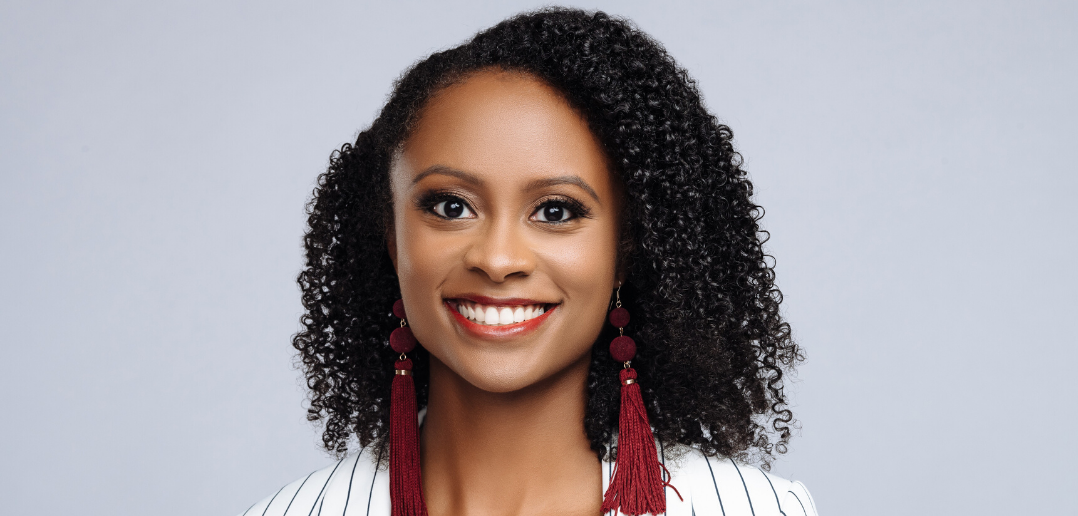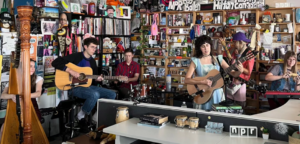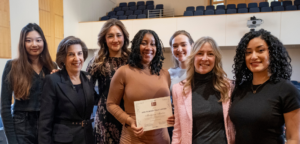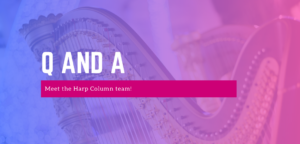Harpist, educator, and activist Angelica Hairston’s work in the arts has been recognized for its impressive vision and scope. Last year she was named a SphinxLead fellow, a mentorship program created to empower arts leaders of color and also received a 2019 Governor’s Award for her contributions to Georgia’s civic and cultural vitality. One of these contributions is her Atlanta–based project, Challenge the Stats, a robust program that presents concerts, educational workshops, and community–based discussions intended to spark social change. With the current attention in the United States on issues of racial equality and justice, we reached out to Angelica to get her thoughts on the movement.

from left: Angelica Hairston, Charles Overton, and Mason Morton at the first Challenge the Stats event in 2016
You started Challenge the Stats in 2016 with an event that showcased a number of highly talented, conservatory–trained Black and Latinx musicians. What was your goal when you organized that event?
Challenge the Stats started as a single concert event during my time as a Master of Music Industry Leadership student at Northeastern University. As a student studying music business, I wasn’t offered the opportunity to perform recitals as I’d done during my time in conservatory. I knew I had to create my own space to perform, and I wanted to use my platform to share the stage with a community of artists who were underrepresented in our field.
The initial goal was to celebrate Black and Latinx artists and create dialogue about ways to increase access to the classical arts field for communities of color. Little did I know that the concert would evolve into a thriving and impactful organization that works to empower artists of color and use music as a tool to speak truth to the realities of injustice in our nation. It’s been quite a wild ride, and I’m grateful for the mentors and for the support I’ve had along the way!

Angelica Hairston performing with dancer Michael Morris Jr.
What has been meaningful to you as Challenge the Stats has grown over the past four years?
One of the most beautiful things I’ve seen emerge from the work of Challenge the Stats is a very special community of support where artists can show up as their full selves—an experience that many BIPOC artists don’t often get to experience in this field.
Challenge the Stats artists consistently step on stage as “the first” or “the only” BIPOC people in countless classical music settings. While the excitement of trailblazing can sound thrilling, it’s also an incredibly isolating, vulnerable, and exhausting experience.
When a group of artists who’ve all felt the tinge of being the “only” finally have a moment where they aren’t on stage alone, it’s a deeply healing experience. I think that’s what makes our ability to advocate together that much stronger; we are a part of a family where there’s a shared basis of experience and belonging. This freedom allows for artists to show up fully as themselves and take the stage with a layer of honesty that isn’t always afforded in our field.
With the tragic deaths of Ahmaud Arbery, Breonna Taylor, and George Floyd, it seems like more people in the United States are starting to recognize the injustices that face the Black community. What’s the best way for musicians to join the conversation?
If we could speak with Ahmaud or Breonna or George or the long list of Black people who’ve had their lives cut short, I think they’d agree that injustice is not something we can ignore, and the time for action is right now.
Author and scholar Dr. Beverly Daniel Tatum uses a powerful analogy that puts the reality of racism and complicity into perspective. “Visualize standing on a moving walkway at the airport. Unless you make the active choice to walk in the opposite direction and at a faster speed than the belt’s movement, you’ll find yourself carried along in the direction of racism.”
It’s a sobering reminder that there is no neutrality in this work. Each one of us has a responsibility to intentionally walk the pathway toward transformational change. The good news is that as artists, we’ve been perfecting the skills of advocacy our entire careers.
So where do we start? Research! In order to convey a piece of music with confidence, we must know the context. We learn more about a piece by finding reliable sources of information, reading books, articles, or listening to podcasts. We can use the same research process to gain a better understanding of the history of the founding of our nation and the ways in which our behaviors either contribute to or dismantle existing systems of oppression.
Once we’re walking the pathway toward expanding our knowledge, now comes the most critical piece of the process: take action! As artists, our voices and artistry have undeniable power. If we say we want to see equity in our society, we have a responsibility to reflect that in our actions.

So what are some actions that you’d like to see harpists take?
The first step for many harpists is to take a look at your music. If you have little to no works by Black composers, can you commit to finding new works to add to your repertoire? This can be through existing works, transcriptions, or commissions. Redistributing the wealth in the arts community through commissions is a great way to support living Black composers and expand the musical canon for the harp community at large.
When performing chamber music, what artists are you engaging? Are there ways you can expand your network to include and compensate Black artists who can perform alongside you?
If you’re planning a concert, who are the partner organizations? Can you donate your artist fees or the proceeds from your program to an organization advocating for justice?
If you are a teacher, take a look at your curriculum. Are you including the voices of Black artists in your teaching materials? Are there ways to amplify the experiences of Black artists in your approach?
If you teach Black students, how are you engaging with these musicians? Are you honest with them about the realities of the professional arts field that you’re preparing them to enter? Do you have Black artists in your network who would be open to serving as a mentor for your students?
If you teach non–Black students, how are you engaging with these musicians? Are you actively taking steps to help them increase their knowledge of and respect for Black voices in the arts field and in their daily lives?
If you are in higher education, who are you engaging for masterclasses? What topics are they covering? Can subject matter be expanded to include conversations around equity?
As much as we wish it did, I think we can all agree that practice doesn’t always make perfect. I’ve had plenty of performances where I’ve worked so hard in the practice room only to have a memory slip or forget a pedal on stage. It’s frustrating! But that does not mean I throw in the towel. As musicians, when we don’t quite hit the mark, we keep pushing forward knowing that through consistent study, practice, and putting ourselves out there, we’ll become better artists and ultimately better people in the process. The same is true in this work of building equity in our field. We never truly “arrive” as an advocate or an ally. Just like the study of music, there is always more to learn.

Angelica Hairston performing with violinist Jessica Robinson Stinson
I know Challenge the Stats has a virtual concert and discussion coming up this Saturday, June 27, called “Music for the Crisis.” Tell us a little bit about what to expect on that program.
We’re so excited for the “Music for the Crisis” concert airing on June 27th at 8PM EST! The program highlights a group of Black composers and 11 Black musicians who will use their music and their voices to speak out in response to the disproportionate effect of racial injustice surfacing in this time of COVID19. I’m thrilled to be giving the Southeastern premiere of Brandee Younger’s harp solo “Essence of Ruby” as part of the virtual concert. A Facebook Live pre–concert discussion begins at 7:15PM EST between myself, composer Joel Thompson, and Dr. Adrianne Ross. View it at facebook.com/ChallengetheStats.
The concert seems like it will be packed with amazing music and performers—I can’t wait to tune in. Before I let you go, who are some Black artists that have inspired you throughout your career?
I’d say Ann Hobson Pilot has always been a model of excellence and a beacon of authentic support for me. Robbin Gordon–Cartier has also been an incredible role model as an educator and one of my dearest friends. I’ve learned so much from her along the way and take that learning into my classroom consistently through my work with the Urban Youth Harp Ensemble.
Lately, I’ve been deeply inspired by some of my outstanding harp colleagues who aren’t new to the work of equity in the arts. Black harpists like Elizabeth Steiner, Brandee Younger, Ashley Jackson, Charles Overton, and Mallory McHenry among others have been doing this work long before this moment of unrest in our nation. It’s encouraging to be reminded that even when you feel isolated, there are others who are truly pushing for transformational change alongside you. For those reading this Q and A, I certainly hope you’ll stand with us as we all move toward lasting change together.
Learn more about Angelica at angelicahairston.com or visit challengethestats.org to get more information about the concert on June 27.











